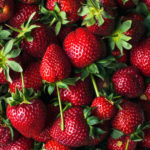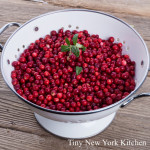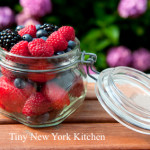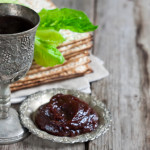Though they are available year-round in grocery stores the best strawberries are to be found in farmer’s markets in spring and early summer.
Look for smaller berries, preferably organic ones, with a rich, glossy red color and shiny green leaves. Avoid berries with white or green shoulders and brown or limp leaves. Never buy them if they are moist, overly soft or show signs of mold. Do not buy berries if their cartons are leaking and wet, a sure sign that unseen fruits will be moldy.
Although fresh strawberries should be rinsed, do not soak them for any length of time since they will absorb the water and turns mushy. For eating on their own, strawberries, even very large ones, should be left whole. Hull strawberries before freezing them or using them for most preparations. Use a small paring knife or a strawberry huller to carve out the white center core from the stem end of each berry. To improve the flavor of lackluster strawberries, hull and slice them, place in a bowl and sprinkle with a tablespoon or two of sugar for every pint. Let stand at room temperature for at least 15 minutes. The sugar draws moisture from the berries to make a sweet natural syrup.
Fresh strawberries are fragile so handle them with care. Don’t wash the berries until just before you are ready to eat them, as the moisture will encourage mold. To store strawberries, line a glass or plastic container with paper towels, carefully arrange the berries inside and cover with the lid. They will keep in the refrigerator for up to 1 week.
©Tiny New York Kitchen © 2021 All Rights Reserved
These freezer essentials will help you with your weekly meal prep as well as last minute meals that you need to get on the table fast.
Bagged frozen vegetables, like mixed peppers, broccoli, and spinach.
Bagged frozen fruit, like blueberries, mangos, bananas, and strawberries.
Bagged frozen pastas, like tortellini and ravioli.
Frozen waffles and pancakes.
Frozen potatoes, like tots, fries, and breakfast potatoes.
Rice and prepared side dishes.
Pre-made dough, pie crusts, and breads.
Frozen foods are not limited to frozen dinners. You can stock your freezer with healthier ingredients to make putting dinner together easy. There are endless possibilities with what you can make with frozen ingredients. As always, be creative and “work with what you got!”
“Work With What You Got!”
©Tiny New York Kitchen © 2020 All Rights Reserved
You may substitute any berries for this delicious mug cake.
“Work With What You Got!”
©Tiny New York Kitchen © 2019 All Rights Reserved
Strawberries are the irresistible taste of spring. They’re juicy, refreshing, great for pies, excellent for picnics, and perfectly in season.
Strawberries aren’t truly berries, because of their seeds that are on the outside. An average strawberry has approximately 200 seeds. If you don’t want the seeds on your strawberries, you can gently peel off the outside with a paring knife.
Strawberries are known for sweet jams and tarts, but they are an excellent base for savory recipes as well, like spicy salsas, glazes for meats, and endless fresh green combinations in strawberry salads.
Ounce for ounce, strawberries have more vitamin C than an orange. They are also full of antioxidants. Consuming a serving a day (about 1 cup of sliced strawberries) will even boost your immune system. These same qualities make strawberries a great exfoliating face mask. Just mash 9 strawberries, mix in 2 tablespoons of honey, and apply over your face (avoid your eyes). Wash away the mask after 10 minutes and your skin will shine.
It’s so disappointing to buy strawberries and they end up having no flavor. Here are ways that you can tell if you’re buying the best strawberries.
The Smell Test! Strawberries that are ready for eating have a sweet, delicious scent.
Color Check! Look for a bright red color. That’s the best indication of flavor. A strawberry with too much white was not picked in its prime.
Bottoms Up! Most of the strawberries are hidden in the box interior. Check the bottom of the box will let you see if there are small pools of juice leaking and if any strawberries have been squashed.
After you’ve brought home your delicious strawberries make sure to keep them dry. Don’t wash them until just before you’re ready to use them. This will keep them lasting longer.
When hulling strawberries you may want to give this trick a try. Instead of chopping off the whole leafy top of a strawberry, poke a drinking straw into the bottom of the strawberry and push it all the way through to the other side, until the top pops off, or use a paring knife or teaspoon to scoop out just the green.
“Work With What You Got!”
© Victoria Hart Glavin Tiny New York Kitchen © 2017 All Rights Reserved
Just a few fresh berries add color and nutrients to a salad, cocktail, or mocktail.
Stock up on fresh berries, wash and freeze them in a single layer on a sheet pan. Then transfer to a freezer bag for future smoothies and baked goods.
Add a handful of berries to a parfait, with yogurt for breakfast or ice cream for dessert.
Gently fold berries into muffin and pancake batter. Cook a big batch and freeze some for easy breakfasts later.
Make into a savory salsa and serve as a dip or over grilled chicken or wild-caught salmon.
“Work With What You Got!”
© Victoria Hart Glavin Tiny New York Kitchen © 2017 All Rights Reserved
Cranberries
These tart, bright ruby-red berries grow wild on evergreen shrubs in peaty marshland all over northern Europe and North America. They are closely related to blueberries and bilberries, but are much more sour and are always served cooked. They are closely related to cowberries and lingonberries.
Cranberries are sometimes known as bouceberries since they were traditionally tested for firmness by being bounced seven times. Any berries that failed the bounce test were too squashy and were, therefore, discarded. Because of their waxy skins, cranberries keep for much longer than other berries, which helps to explain their popularity.
Cranberries contain useful amounts of vitamins C and D, potassium and iron. They used to be considered to be good protection against scurvy, and they are known to contain a natural antibiotic. Cranberry juice has long been recommended as a natural remedy for cystitis, kidney, bladder and urinary tract infections.
Look for plump, firm, bright, red berries and check the base of the carton in case of squashed or shriveled berries. Fresh cranberries will keep in the refrigerator for four weeks, or freeze them in plastic bags.
Cranberries can be used in both sweet and savory dishes or can be juiced and served as a drink. Their most famous incarnation is as cranberry sauce. The berries are high in pectin, so they make excellent jams and jellies. They also combine well with orange and apple, and can be mixed with blackberries and raspberries for an autumn version of summer pudding. Cranberry sorbet is a delicious treat. When cooking them for a sweet dish, do not add the sugar until the skins have popped or they will become tough.
“Work With What You Got!”
© Victoria Hart Glavin Tiny New York Kitchen © 2016 All Rights Reserved
Care & Handling Of Berries
Strawberries: Pick strawberries at their peak of ripeness. Look for symmetrically shaped berries; a brilliant sheen and rich even red color; fresh unwilted green caps; avoid strawberries with seedy tips or white shoulders. A white “core” in your strawberries is not an indication of ripeness. The internal pigment of strawberries ranges from white to bright red and is a characteristic of the berry plant variety and not of the berries’ ripeness or flavor.
Raspberries: When choosing raspberries look for plump, evenly colored berries that have a soft and hazy gloss and are free of dents and bruises. Raspberries have tiny hairs on them called “styles.” These are a completely natural part of the fruit’s defense mechanism and do not affect the taste or ripeness of the berries.
Blueberries: Choose blueberries that are dry, plump, round and free of dents and bruises. Blueberries should have a soft , hazy white coating, which is called “bloom.” Bloom is a completely natural part of the berries’ defense mechanism and helps protect them from the harsh rays of the sun. Avoid blueberries that are shriveled or lack bloom.
Blackberries: Look for deep, evenly colored blackberries with a nice sheen. Berries that are plump and dry and free of dents or bruises. Blackberries range in color from deep blue/purple to deep purple/black. Blackberries are often two-tone in color, which is perfectly natural and does not affect ripeness.
All fresh berries are highly perishable and should be refrigerated at all times until eaten or used as an ingredient. Refrigeration will extend freshness and shelf life.
It is recommended that you wash all berries before using them. However, you should never wash your berries until just before you are ready to eat or use them, as the moisture will decrease their shelf life.
Fresh berries can be easily frozen and enjoyed until you are ready to use them.
Wash strawberries carefully in cold water and pat dry. Remove the stems and any soft spots. Pack the berries into freezable containers or freeze them on a baking sheet and then pack them into containers as soon as they are frozen. Seal containers and keep frozen until you are ready to use them.
Raspberries and blackberries are very fragile and fresh raspberries are very sensitive to freeze damage. To freeze raspberries and blackberries rinse them gently in cool water then allow them to dry in a colander or on paper towels. Place a sheet of wax paper on a baking sheet then place berries in freezer. After berries are frozen, pack them into sealed containers until you are ready to use them. By freezing the berries this way, they won’t stick to each other which allows you to easily measure out the needed amount once you are ready to use them.
If you plan to freeze your blueberries, do not wash them before freezing as doing so will make the blueberry skins tough. Instead pack your blueberries into freezable containers, or freeze them on a baking sheet and then pack the into containers as soon as they are frozen. Seal the container and keep frozen until you are ready to use them. Be sure to wash the thawed blueberries prior to use.
Berries are delicious, nutritious, disease-fighting fruits. With their high antioxidant levels, berries are also considered “superfoods” because their health benefits may help the body fight off disease and slow the effect of aging. Berries are also high in vitamins and low in calories so they are a perfect fruit to include in your daily diet.
Antioxidants are natural substances found in plants, which are known, to aide in the prevention of heart disease, cancer and strokes. They provide protection by neutralizing free radicals, which are substances that form when oxygen is burned by the body. Free radicals travel through cells, disrupting the structure of other molecules, causing cellular damage. This cell damage is believed to contribute to aging and various health problems. In addition to boosting your immune system, antioxidants have been found to slow the effects of aging by improving memory, balance, coordination and motor skills. Berries are some o the most delicious and powerful disease-fighting foods available. Considered “superfoods,” antioxidant levels in berries are measured by their ORAC (Oxygen Radical Absorbance Capacity) Value.
“Work With What You Got!”
© Victoria Hart Glavin Tiny New York Kitchen © 2016 All Rights Reserved
















